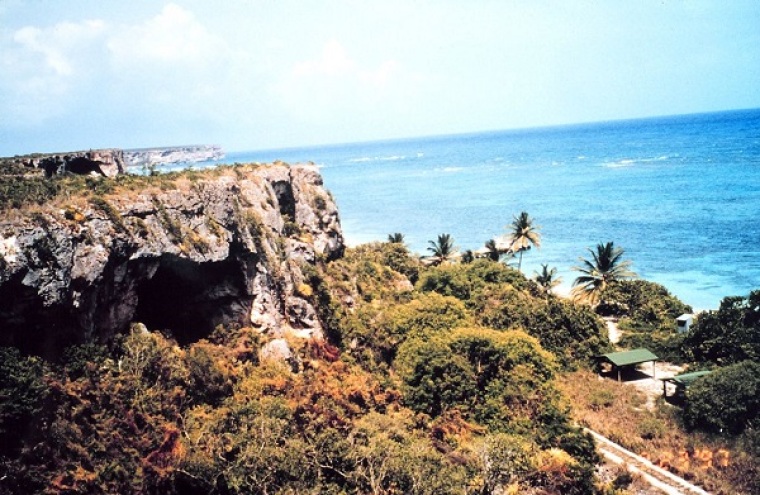Cave inscriptions reveal how early Christians evangelized natives on Caribbean island
Inscriptions found in a cave on a Caribbean island give clues as to how Christians shared the message of the gospel to the island's inhabitants despite the language and cultural barriers.

The drawings, discovered in Mona Island by archaeologists from the University of Leicester and the British Museum, showed how Europeans communicated to the local inhabitants regarding spiritual truths.
Mona Island, which is no longer inhabited, lies about 40 miles west of Puerto Rico. It has an intensive cave system composed of about 200 caves. Of these, 70 have been explored by archaeologists, who reported seeing various figures drawn on the cave walls using fingernails or sharp-edged tools.
"These finger-fluted designs reflect the spiritual beliefs of the indigenous people," Jago Cooper from the British Museum said, according to National Geographic.
Archaeologists also found more than 30 inscriptions of Spanish and Latin phrases. One of the inscriptions read, "God forgive you." Another one said, "God made many things."
A Latin inscription was lifted from the Vulgate and quoted a text from John 1:14: "And the Word was made flesh [and dwelt among us]."
Some of the inscriptions were abbreviations of the name of Jesus. Drawings of Christian crosses were also found.
"What we are seeing in this Caribbean cave is something different," Alice Samson from the University of Leicester said, according to The Guardian. "This is not zealous missionaries coming with their burning crosses, they are people engaging with a new spiritual realm and we get individual responses in the cave and it is not automatically erasure, it is engagement."
The names of the persons who wrote the inscriptions were also found on the cave walls. One of the names was that of Francisco Alegre, a Spaniard from Puerto Rico who was in charge of several royal estates including the island.
The discovery is "truly extraordinary," according to Cooper. He said the drawings and inscriptions were "proof" that early Europeans had an encounter with an indigenous worldview.
As reported in the journal Antiquity, the researchers said the spiritual encounters documented in the cave give a new insight about "intercultural religious dynamics in the early Americas."
 Christians don't have to affirm transgenderism, but they can’t express that view at work: tribunal
Christians don't have to affirm transgenderism, but they can’t express that view at work: tribunal Archaeology discovery: Medieval Christian prayer beads found on Holy Island
Archaeology discovery: Medieval Christian prayer beads found on Holy Island Presbyterian Church in America votes to leave National Association of Evangelicals
Presbyterian Church in America votes to leave National Association of Evangelicals Over 50 killed in 'vile and satanic' attack at Nigerian church on Pentecost Sunday
Over 50 killed in 'vile and satanic' attack at Nigerian church on Pentecost Sunday Ukrainian Orthodox Church severs ties with Moscow over Patriarch Kirill's support for Putin's war
Ukrainian Orthodox Church severs ties with Moscow over Patriarch Kirill's support for Putin's war Islamic State kills 20 Nigerian Christians as revenge for US airstrike
Islamic State kills 20 Nigerian Christians as revenge for US airstrike Man who served 33 years in prison for murder leads inmates to Christ
Man who served 33 years in prison for murder leads inmates to Christ


 Nigerian student beaten to death, body burned over ‘blasphemous’ WhatsApp message
Nigerian student beaten to death, body burned over ‘blasphemous’ WhatsApp message 'A new low': World reacts after Hong Kong arrests 90-year-old Cardinal Joseph Zen
'A new low': World reacts after Hong Kong arrests 90-year-old Cardinal Joseph Zen Iran sentences Christian man to 10 years in prison for hosting house church worship gathering
Iran sentences Christian man to 10 years in prison for hosting house church worship gathering French Guyana: Pastor shot dead, church set on fire after meeting delegation of Evangelicals
French Guyana: Pastor shot dead, church set on fire after meeting delegation of Evangelicals ‘Talking Jesus’ report finds only 6% of UK adults identify as practicing Christians
‘Talking Jesus’ report finds only 6% of UK adults identify as practicing Christians Mission Eurasia ministry center blown up in Ukraine, hundreds of Bibles destroyed: 'God will provide'
Mission Eurasia ministry center blown up in Ukraine, hundreds of Bibles destroyed: 'God will provide' Church holds service for first time after ISIS desecrated it 8 years ago
Church holds service for first time after ISIS desecrated it 8 years ago Burger King apologizes for 'offensive campaign' using Jesus' words at the Last Supper
Burger King apologizes for 'offensive campaign' using Jesus' words at the Last Supper Uganda: Muslims abduct teacher, burn him inside mosque for praying in Christ’s name
Uganda: Muslims abduct teacher, burn him inside mosque for praying in Christ’s name